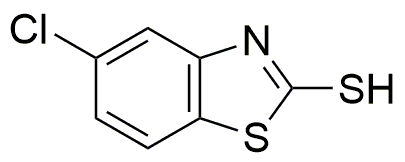5-Chloro-2-mercaptobenzothiazole is widely utilized in research focused on:
- Antimicrobial Agents: This compound is effective in developing antimicrobial formulations, particularly in the textile and coating industries, where it helps prevent bacterial and fungal growth.
- Rubber Industry: It serves as a vulcanization accelerator in rubber production, enhancing the durability and elasticity of rubber products, which is crucial for automotive and industrial applications.
- Corrosion Inhibitors: Used in metalworking fluids, it protects metals from corrosion, thereby extending the lifespan of machinery and equipment in various industries.
- Pesticide Formulations: This chemical is incorporated into agricultural products to enhance pest resistance, providing farmers with effective tools for crop protection.
- Research in Biochemistry: It is employed in laboratory settings to study enzyme inhibition and other biochemical pathways, offering insights into drug development and disease mechanisms.
General Information
Properties
Safety and Regulations
Applications
5-Chloro-2-mercaptobenzothiazole is widely utilized in research focused on:
- Antimicrobial Agents: This compound is effective in developing antimicrobial formulations, particularly in the textile and coating industries, where it helps prevent bacterial and fungal growth.
- Rubber Industry: It serves as a vulcanization accelerator in rubber production, enhancing the durability and elasticity of rubber products, which is crucial for automotive and industrial applications.
- Corrosion Inhibitors: Used in metalworking fluids, it protects metals from corrosion, thereby extending the lifespan of machinery and equipment in various industries.
- Pesticide Formulations: This chemical is incorporated into agricultural products to enhance pest resistance, providing farmers with effective tools for crop protection.
- Research in Biochemistry: It is employed in laboratory settings to study enzyme inhibition and other biochemical pathways, offering insights into drug development and disease mechanisms.
Documents
Safety Data Sheets (SDS)
The SDS provides comprehensive safety information on handling, storage, and disposal of the product.
Product Specification (PS)
The PS provides a comprehensive breakdown of the product’s properties, including chemical composition, physical state, purity, and storage requirements. It also details acceptable quality ranges and the product's intended applications.
Certificates of Analysis (COA)
Search for Certificates of Analysis (COA) by entering the products Lot Number. Lot and Batch Numbers can be found on a product’s label following the words ‘Lot’ or ‘Batch’.
*Catalog Number
*Lot Number
Certificates Of Origin (COO)
This COO confirms the country where the product was manufactured, and also details the materials and components used in it and whether it is derived from natural, synthetic, or other specific sources. This certificate may be required for customs, trade, and regulatory compliance.
*Catalog Number
*Lot Number
Safety Data Sheets (SDS)
The SDS provides comprehensive safety information on handling, storage, and disposal of the product.
DownloadProduct Specification (PS)
The PS provides a comprehensive breakdown of the product’s properties, including chemical composition, physical state, purity, and storage requirements. It also details acceptable quality ranges and the product's intended applications.
DownloadCertificates of Analysis (COA)
Search for Certificates of Analysis (COA) by entering the products Lot Number. Lot and Batch Numbers can be found on a product’s label following the words ‘Lot’ or ‘Batch’.
*Catalog Number
*Lot Number
Certificates Of Origin (COO)
This COO confirms the country where the product was manufactured, and also details the materials and components used in it and whether it is derived from natural, synthetic, or other specific sources. This certificate may be required for customs, trade, and regulatory compliance.

